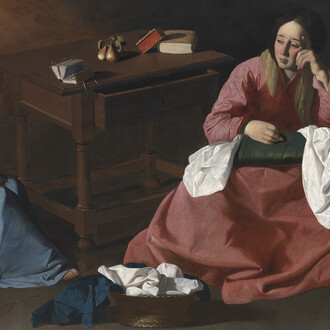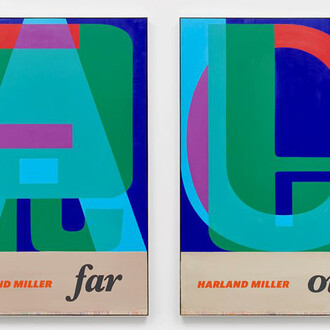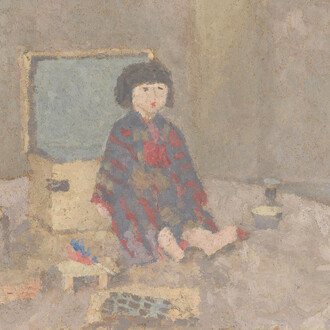Skarstedt is pleased to present Shades of grey, a group exhibition which spans the achromatic tones between black and white and emphasises the quiet beauty derived from the absence of colour. The exhibition features work by Martin Barré, Georg Baselitz, John Bock, George Condo, Hans Josephsohn, Kaws, Robert Mapplethorpe, Albert Oehlen, Richard Prince, Paula Rego, Gerhard Richter, Rudolf Stingel, Andy Warhol, Fischli and Weiss, James White and Christopher Wool. Working throughout the twentieth and twenty-first centuries, these artists are not limited to a specific time or medium but instead, are united by their common tonality.
In the early 1970s, Gerhard Richter investigated the banality of grey, asserting, ‘Grey. Evokes neither feelings nor associations, it is really neither visible nor invisible […] it has the capacity that no other colour has to make nothing ‘visible’’1. His introspective masterpiece Ohne titel (1970) captures the nihilist aesthetic that permeated post-war Germany yet still conveyed elements of the sublime. For this reason, Richter used the stripped-back palette to investigate the paradoxes of painting, much like fellow German artist, Albert Oehlen. In Titankatze mit versuchstier (titanium cat with laboratory tested animal) (1999) Oehlen pushes the boundaries of perception by restricting himself to grey to ‘artificially heighten the lust for colour’2, exposing the limitations of painting. On the other hand, Peter Fischli and David Weiss explore the poetics of banality in Small cupboard (1987), a life-sized work created entirely from black rubber. The object is defunct of purpose, stripped of utility and rendered in a deep black to emphasise its ‘nothingness’ illustrating the artist’s fascination with the mundane and absurd.
The purpose of painting has long been questioned within contemporary art, and artists like Christopher Wool, John Bock, Rudolf Stingel and Richard Prince approach the problem with ingenuity and humour. Prince’s What’s his face (1989) belongs to the series of White Paintings which build upon and appropriate his earlier Joke Paintings (1984-1990). In keeping with the series title, these paintings are starkly neutral, blending superimposed silk-screened found imagery, hand-written text and stencilled letters. Likewise, Christopher Wool eschews colour for a mechanical aesthetic. In Gate (P14) (1986) Wool consciously oscillates between the predictability of commercial reproduction and the inconsistency of artistic touch, using a ready-made pattern roller with alkyd paint to enforce its industrial qualities. In the same vein, Rudolf Stingel’s Untitled (2012) from the celebrated series of Carpet paintings, offers a vast, painted recreation of a Middle Eastern rug, radiating opulence. By translating this object into the medium of paint, Stingel begs to question the relationship between art and décor, illustrating his ambition for immersive painting. Conversely, Martin Barré, working in the proceeding years, revolutionised abstract painting from a proto-minimalist standpoint. Renowned for his ground-breaking compositional methods, Barré sprayed minimal black paint onto a white canvas, rejoicing in empty space and rejecting contemporaneous trends.
For James White and Robert Mapplethorpe, to withhold colour is to elevate the ordinary and capture the beauty in form. Whilst Mapplethorpe uses a camera lens to achieve his goals, White paints in a photorealistic style, capturing the quotidian moments from a film noir angle. White presents Double glass (2018), a composition split in two, denoting the presence of time whilst focussing on the everyday effulgence of overlooked corners. Conversely, Mapplethorpe imbues a certain sensuality into his still-life portraits which is epitomised through Tulip (1982). The flower arches sensitively across the frame in an oddly anthropomorphic manner demonstrating the artist’s mastery of shadows and form.
The absence of colour in sculpture is often anticipated but is by no means certain. Whilst George Condo and Hans Josephsohn embrace the dignified colours of bronze and brass, Kaws lends his sculpture, Gone (2020) a distinctly modern finish. Known for his dark Pop aesthetic, Kaws emulates the stance of Michelangelo’s Pieta (1498-1499) through his famed characters Companion and Bff, instilling a humorous edge to a melancholic work. In keeping with its title, Kaws uses a black colourway, absorbing light and imparting a ghost-like ephemerality to the life-sized statue.
Thus far, 256 shades of grey have been established and this exhibition highlights some of the many ways the colour has been used in painting, sculpture and works on paper. At times thought-provoking, and even amusing, the works on display offer a moment to consider the transcendent, banal and occasionally the contradictions of painting.
Notes
1 Gerhard Richter in a letter to Edy de Wilde, 23 February 1975 in H.-U. Obrist (ed.), Gerhard Richter, The daily practice of painting, London, Thames and Hudson, 1995, pp. 82-83.
2 H. W. Holzwarth, ed., Albert Oehlen, Cologne, Taschen, 2009, p. 378.
















